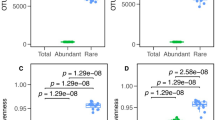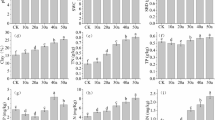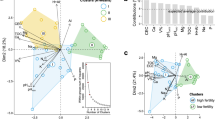Abstract
Aims
Characterizing the roles of abundant and rare soil microorganism is vital for clarifying microbial functions and help optimize agricultural management strategies, but their responses to various amendments in acid soils and correlations with crop biomass remain poorly understood.
Methods
A 5-year field experiment was conducted to evaluate the influence of amendments, including canola straw (SC), animal manure (OM), and alkaline slag (AS), on abundant and rare bacteria or fungi in acidic bulk and rhizosphere soils in aspect of microbial diversity, compositions, potential functions, and their relationship with canola biomass.
Results
Amendments and canola planting significantly affected both bacterial and fungal community structures. Applying AS had pronounced effect on bacterial communities and sub-communities, and the addition of OM showed the strong influence on fungal communities and sub-communities. The sub-community structures of rare bacterial and rare fungal significantly correlated to canola biomass; this correlation was stronger in the rhizosphere soil than that in the bulk soil. The α-diversity of rare rhizosphere bacteria, but not rare bulk bacteria and rare fungi, was significantly positively related to canola biomass. Rare bacteria accounted for the high proportion of nodes and most keystone species in microbial networks, and the number of edges belonging to rare bacteria positively correlated to canola biomass. The predicted functions of rare bacteria also make large contributions to crop biomass.
Conclusions
These findings highlight the important roles that rare microbes play in ameliorating acid soils and suggest that rare bacteria should be more closely associated with crop growth than rare fungi.







Similar content being viewed by others
Data availability
The data that support the findings of this study are available from the corresponding author upon reasonable request.
References
Brunel C, Pouteau R, Dawson W, Pester M, Ramirez KS, van Kleunen M (2020) Towards unraveling macroecological patterns in rhizosphere microbiomes. Trends Plant Sci 25:1017–1029
Chen J, Wang P, Wang C, Wang X, Miao L, Liu S, Yuan Q (2018) Bacterial communities in riparian sediments: a large-scale longitudinal distribution pattern and response to dam construction. Front Microbiol 9:999
Chen QL, Ding J, Zhu D, Hu HW, Delgado-Baquerizo M, Ma YB, He JZ, Zhu YG (2020) Rare microbial taxa as the major drivers of ecosystem multifunctionality in long-term fertilized soils. Soil Biol Biochem 141:107686
de Vries FT, Griffiths RI, Bailey M, Craig H, Girlanda M, Gweon HS, Hallin S, Kaisermann A, Keith AM, Kretzschmar M, Lemanceau P, Lumini E, Mason KE, Oliver A, Ostle N, Prosser JI, Thion C, Thomson B, Bardgett RD (2018) Soil bacterial networks are less stable under drought than fungal networks. Nat Commun 9:3033
Delgado-Baquerizo M, Eldridge DJ, Ochoa V, Gozalo B, Singh BK, Maestre FT (2017) Soil microbial communities drive the resistance of ecosystem multifunctionality to global change in drylands across the globe. Ecol Lett 20:1295–1305
Deng Y, Jiang YH, Yang YF, He ZL, Luo F, Zhou JZ (2012) Molecular ecological network analyses. BMC Bioinformatics 13:113
Edgar RC, Haas BJ, Clemente JC, Quince C, Knight R (2011) UCHIME improves sensitivity and speed of chimera detection. Bioinformatics 27:2194–2200
Galand PE, Pereira O, Hochart C, Auguet JC, Debroas D (2018) A strong link between marine microbial community composition and function challenges the idea of functional redundancy. ISME J 12:2470–2478
Gao GF, Peng D, Tripathi BM, Zhang YH, Chu HY (2020) Distinct community assembly processes of abundant and rare soil bacteria in coastal wetlands along an inundation gradient. mSystems 5:e01150-e1220
Ge T, Li B, Zhu Z, Hu Y, Yuan H, Dorodnikov M, Jones DL, Wu J, Kuzyakov Y (2016) Rice rhizodeposition and its utilization by microbial groups depends on N fertilization. Biol Fertil Soils 53:37–48
Goss-Souza D, Mendes LW, Borges CD, Rodrigues JLM, Tsai SM (2019) Amazon forest-to-agriculture conversion alters rhizosphere microbiome composition while functions are kept. FEMS Microbiol Ecol 95:fiz009
Guo JH, Liu XJ, Zhang Y, Shen JL, Han WX, Zhang WF, Christie P, Goulding KWT, Vitousek PM, Zhang FS (2010) Significant acidification in major Chinese croplands. Science 327:1008–1010
Hol WHG, de Boer W, de Hollander M, Kuramae EE, Meisner A, van der Putten WH (2015) Context dependency and saturating effects of loss of rare soil microbes on plant productivity. Front Plant Sci 6:485
**g J, Cong WF, Bezemer TM (2022) Legacies at work: plant-soil-microbiome interactions underpinning agricultural sustainability. Trends Plant Sci 27:781–792
Jousset A, Bienhold C, Chatzinotas A, Gallien L, Gobet A, Kurm V, Kusel K, Rillig MC, Rivett DW, Salles JF, van der Heijden MG, Youssef NH, Zhang X, Wei Z, Hol WH (2017) Where less may be more: how the rare biosphere pulls ecosystems strings. ISME J 11:853–862
Kochian LV, Hoekenga OA, Pineros MA (2004) How do crop plants tolerate acid soils? Mechanisms of aluminum tolerance and phosphorous efficiency. Annu Rev Plant Biol 55:459–493
Landi L, Valori F, Ascher J, Renella G, Falchini L, Nannipieri P (2006) Root exudate effects on the bacterial communities, CO2 evolution, nitrogen transformations and ATP content of rhizosphere and bulk soils. Soil Biol Biochem 38:509–516
Lauber CL, Strickland MS, Bradford MA, Fierer N (2008) The influence of soil properties on the structure of bacterial and fungal communities across land-use types. Soil Biol Biochem 40:2407–2415
Li S, Liu J, Yao Q, Yu Z, Li Y, ** J, Liu X, Wang G (2021) Short-term lime application impacts microbial community composition and potential function in an acid black soil. Plant Soil 470:35–50
Liang Y, **ao X, Nuccio EE, Yuan M, Zhang N, Xue K, Cohan FM, Zhou J, Sun B (2020) Differentiation strategies of soil rare and abundant microbial taxa in response to changing climatic regimes. Environ Microbiol 22:1327–1340
Lin Y, Ye G, Liu D, Ledgard S, Luo J, Fan J, Yuan J, Chen Z, Ding W (2018) Long-term application of lime or pig manure rather than plant residues suppressed diazotroph abundance and diversity and altered community structure in an acid Ultisol. Soil Biol Biochem 123:218–228
Ling N, Wang T, Kuzyakov Y (2022) Rhizosphere bacteriome structure and functions. Nat Commun 13:836
Logares R, Audic S, Bass D, Bittner L, Boutte C, Christen R, Claverie JM, Decelle J, Dolan JR, Dunthorn M, Edvardsen B, Gobet A, Kooistra WH, Mahe F, Not F, Ogata H, Pawlowski J, Pernice MC, Romac S, Shalchian-Tabrizi K, Simon N, Stoeck T, Santini S, Siano R, Wincker P, Zingone A, Richards TA, de Vargas C, Massana R (2014) Patterns of rare and abundant marine microbial eukaryotes. Curr Biol 24:813–821
Louca S, Parfrey LW, Doebeli M (2016) Decoupling function and taxonomy in the global ocean microbiome. Science 353:1272–1277
Lu T, Ke M, Lavoie M, ** Y, Fan X, Zhang Z, Fu Z, Sun L, Gillings M, Penuelas J, Qian H, Zhu YG (2018) Rhizosphere microorganisms can influence the timing of plant flowering. Microbiome 6:231
Miura T, Niswati A, Swibawa IG, Haryani S, Gunito H, Kaneko N (2013) No tillage and bagasse mulching alter fungal biomass and community structure during decomposition of sugarcane leaf litter in Lampung Province, Sumatra, Indonesia. Soil Biol Biochem 58:27–35
Mori AS, Isbell F, Fujii S, Makoto K, Matsuoka S, Osono T (2016) Low multifunctional redundancy of soil fungal diversity at multiple scales. Ecol Lett 19:249–259
Pan XY, Li JY, Deng KY, Xu RK, Shen RF (2019) Four-year effects of soil acidity amelioration on the yields of canola seeds and sweet potato and N fertilizer efficiency in an ultisol. Field Crop Res 237:1–11
Patra AK, Abbadie L, Clays-Josserand A, Degrange V, Grayston SJ, Guillaumaud N, Loiseau P, Louault F, Mahmood S, Nazaret S, Philippot L, Poly F, Prosser JI, Le Roux X (2006) Effects of management regime and plant species on the enzyme activity and genetic structure of N-fixing, denitrifying and nitrifying bacterial communities in grassland soils. Environ Microbiol 8:1005–1016
Pedros-Alio C (2006) Marine microbial diversity: can it be determined? Trends Microbiol 14:257–263
Pedros-Alio C (2012) The rare bacterial biosphere. Ann Rev Mar Sci 4:449–466
Philippot L, Spor A, Henault C, Bru D, Bizouard F, Jones CM, Sarr A, Maron PA (2013) Loss in microbial diversity affects nitrogen cycling in soil. ISME J 7:1609–1619
Shannon P, Markiel A, Ozier O, Baliga NS, Wang JT, Ramage D, Amin N, Schwikowski B, Ideker T (2003) Cytoscape: A software environment for integrated models of biomolecular interaction networks. Genome Res 13:2498–2504
Smith CR, Blair PL, Boyd C, Cody B, Hazel A, Hedrick A, Kathuria H, Khurana P, Kramer B, Muterspaw K, Peck C, Sells E, Skinner J, Tegeler C, Wolfe Z (2016) Microbial community responses to soil tillage and crop rotation in a corn/soybean agroecosystem. Ecol Evol 6:8075–8084
Sun Y, Deng X, Tao C, Liu H, Shen Z, Liu Y, Li R, Shen Q (2022) Temporal dynamics of rare and abundant soil bacterial taxa from different fertilization regimes under various environmental disturbances. mSystems 7:e0055922
Tripathi BM, Stegen JC, Kim M, Dong K, Adams JM, Lee YK (2018) Soil pH mediates the balance between stochastic and deterministic assembly of bacteria. ISME J 12:1072–1083
Trivedi P, Delgado-Baquerizo M, Jeffries TC, Trivedi C, Anderson IC, Lai K, Mcnee M, Flower K, Singh BP, Minkey D, Singh BK (2017) Soil aggregation and associated microbial communities modify the impact of agricultural management on carbon content. Environ Microbiol 19:3070–3086
Vonuexkull HR, Mutert E (1995) Global extent, development and economic-impact of acid soils. Plant Soil 171:1–15
Wagg C, Schlaeppi K, Banerjee S, Kuramae EE, van der Heijden MGA (2019) Fungal-bacterial diversity and microbiome complexity predict ecosystem functioning. Nat Commun 10:4841
Wang C, Zheng M, Song W, Wen S, Wang B, Zhu C, Shen R (2017) Impact of 25 years of inorganic fertilization on diazotrophic abundance and community structure in an acid soil in southern China. Soil Biol Biochem 113:240–249
Winfree R, Fox JW, Williams NM, Reilly JR, Cariveau DP (2015) Abundance of common species, not species richness, drives delivery of a real-world ecosystem service. Ecol Lett 18:626–635
Wu M, Qin H, Chen Z, Wu J, Wei W (2011) Effect of long-term fertilization on bacterial composition in rice paddy soil. Biol Fertil Soils 47:397–405
**ao X, Liang Y, Zhou S, Zhuang S, Sun B (2018) Fungal community reveals less dispersal limitation and potentially more connected network than that of bacteria in bamboo forest soils. Mol Ecol 27:550–563
**ong C, He JZ, Singh BK, Zhu YG, Wang JT, Li PP, Zhang QB, Han LL, Shen JP, Ge AH, Wu CF, Zhang LM (2021) Rare taxa maintain the stability of crop mycobiomes and ecosystem functions. Environ Microbiol 23:1907–1924
Xun WB, **ong W, Huang T, Ran W, Li DC, Shen QR, Li Q, Zhang RF (2016) Swine manure and quicklime have different impacts on chemical properties and composition of bacterial communities of an acid soil. App Soil Ecol 100:38–44
Zhang Y, Dong S, Gao Q, Ganjurjav H, Wang X, Geng W (2019) “Rare biosphere” plays important roles in regulating soil available nitrogen and plant biomass in alpine grassland ecosystems under climate changes. Agric Ecosyst Environ 279:187–193
Zhang X, Kuzyakov Y, Zang H, Dippold MA, Shi L, Spielvogel S, Razavi BS (2020) Rhizosphere hotspots: Root hairs and warming control microbial efficiency, carbon utilization and energy production. Soil Biol Biochem 148:107872
Zhao WR, Li JY, Jiang J, Lu HL, Hong ZN, Qian W, Xu RK, Deng KY, Guan P (2020) The mechanisms underlying the reduction in aluminum toxicity and improvements in the yield of sweet potato (Ipomoea batatas L.) after organic and inorganic amendment of an acid ultisol. Agric Ecosyst Environ 288:106716
Zheng MM, Wang C, Li WX, Guo L, Cai ZJ, Wang BR, Chen J, Shen RF (2021a) Changes of acid and alkaline phosphatase activities in long-term chemical fertilization are driven by the similar soil properties and associated microbial community composition in acid soil. Eur J Soil Biol 104:103312
Zheng W, Zhao Z, Lv F, Wang R, Wang Z, Zhao Z, Li Z, Zhai B (2021b) Assembly of abundant and rare bacterial and fungal sub-communities in different soil aggregate sizes in an apple orchard treated with cover crop and fertilizer. Soil Biol Biochem 156:108222
Zhou JZ, Ning DL (2017) Stochastic community assembly: does it matter in microbial ecology? Microbiol Mol Biol Rev 81:e2–e17
Zhou Z, Wang C, Luo Y (2020) Meta-analysis of the impacts of global change factors on soil microbial diversity and functionality. Nat Commun 11:3072
Zhou Z, Zhang Y, Zhang F (2022) Abundant and rare bacteria possess different diversity and function in crop monoculture and rotation systems across regional farmland. Soil Biol Biochem 171:108742
Acknowledgements
This work was financially supported by the National Natural Science Foundation of China (Nos. 41877102, 42377125, 42020104004), National Key Research and Development of China (2022YFD1900604), and the Provincial Science and Technology Special Project of **ggangshan Agricultural High-tech Zone (20222-051246).
Author information
Authors and Affiliations
Corresponding author
Additional information
Responsible Editor: Zhi-Chang Chen.
Publisher’s Note
Springer Nature remains neutral with regard to jurisdictional claims in published maps and institutional affiliations.
Supplementary Information
Rights and permissions
Springer Nature or its licensor (e.g. a society or other partner) holds exclusive rights to this article under a publishing agreement with the author(s) or other rightsholder(s); author self-archiving of the accepted manuscript version of this article is solely governed by the terms of such publishing agreement and applicable law.
About this article
Cite this article
Wang, C., Zhang, Z., Li, J.Y. et al. Rare microbes are associated with crop biomass in an acid soil with different amendments. Plant Soil (2024). https://doi.org/10.1007/s11104-024-06811-7
Received:
Accepted:
Published:
DOI: https://doi.org/10.1007/s11104-024-06811-7




